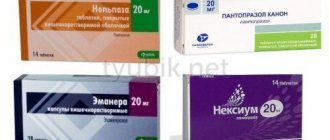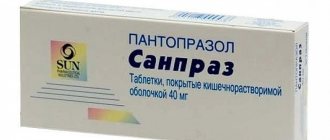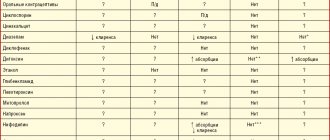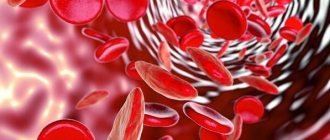Omeprazole is an antisecretory drug used in the treatment of peptic ulcers and erosive-inflammatory diseases of the upper gastrointestinal tract. Acting at the molecular level, Omeprazole suppresses the production and reduces the damaging effect of hydrochloric acid on the gastric mucosa, restores the pH of gastric juice and reduces its activity after meals.
The drug is used for stomach ulcers
By provoking a persistent decrease in acidity, the drug creates optimal conditions for the destruction of H. pylory, which is often the cause of gastritis and peptic ulcers. It is worth noting that Omeprazole becomes active only when it enters the acidic environment of the stomach.
Omeprazole not only significantly improves the well-being of patients, causes a rapid regression of diseases of the stomach and/or duodenum caused by acid disorders, and reduces the likelihood of relapse and the development of complications. Its action begins within 1 hour after ingestion and continues throughout the day.
Indications
Omeprazole has wide indications for diseases of the upper gastrointestinal tract. The drug is usually prescribed to adults and children over 5 years of age in the following cases:
- stomach and duodenal ulcers;
- erosive and ulcerative esophagitis;
- NSAID gastropathy (ulcerative process resulting from potentiated use of non-steroidal anti-inflammatory drugs);
- Zollinger-Ellinson syndrome;
- systemic mastocytosis;
- polyendocrine adenomatosis;
- stress, aspirin and chronic duodenal ulcers of the digestive tract;
- therapy for reflux esophagitis (including long-term treatment of patients with an inactive form of the disease);
- treatment of symptomatic GERD;
- treatment of ulcerogenic adenoma of the pancreas;
- eradication of H. pylori in peptic ulcer disease (in combination with appropriate antibacterial agents);
- to eliminate uncomplicated heartburn that lasts more than 2 days during the week.
Prevention of ulcers and gastritis
- All prevention of gastritis and ulcers is aimed at protecting the stomach and gastrointestinal tract as a whole from unfavorable factors that can become a trigger for the development of gastritis and ulcers. The very first thing is a balanced diet, in which “harmful” foods are excluded or strictly limited: fried foods, smoked and spicy foods, spices, semi-cooked and raw dishes from meat, poultry and fish, alcohol and smoking.
Important: Tobacco smoke spreads throughout the circulatory system instantly and, having a negative effect on blood vessels, can cause spasm, including spasm of the stomach vessels. Which can worsen the quality of the organ’s work.
- The temperature of the food is also important. Too cold or too hot - drinks and solid foods can injure not only the gastric mucosa, but also the esophagus. Which can also cause serious illness.
- The diet in general is also important. Long hungry breaks, constant overeating to the point of “breathing hard”, different meal times, eating before bed - all this is a sure harbinger of imminent problems not only with the stomach, but also with the nervous system.
- Important: do not overuse medications and reach for the first aid kit at the slightest provocation. Uncontrolled use of vitamins, medications and dietary supplements is also a direct path to gastrointestinal disorders.
Interesting Facts:
- It takes 7-10 seconds for food to enter the stomach.
- The stomach of an adult can hold 1.5 liters of liquid
- The stomach is not able to “stretch”. Even after overeating, he is able to return to his true size.
- The muscles of the stomach are so strong that even if we eat upside down, the food will fall where it is needed and remain there.
- The concentration of hydrochloric acid in the stomach is so high that if there were no protective substances in the gastric juice and mucous membrane, it would burn out its own stomach. The stomach acidity coefficient (pH) is 1.2. Which allows you to digest small bones, wood and even plastic!
- The stomach is very closely connected with the parts of the brain that are responsible for emotions. Thus, our emotions can directly influence the functioning of the stomach. The psychosomatics of stomach diseases says that if there is a disease, it means that a person does not “digest” the situation or people in his life well.
So keep an eye on your emotions to stay healthy and happy!
Contraindications
Omeprazole should not be taken in the following cases:
- individual intolerance to the components of the drug;
- pregnancy and lactation;
- age up to 5 years;
- severe forms of liver and kidney failure (with caution);
- malignant tumors of the digestive tract;
- gastrointestinal infections (Omeprazole may increase their reproduction);
- osteoporosis (Omeprazole leaches calcium from bones).
As for osteoporosis, in extreme cases, the attending physician may prescribe complex therapy, including calcium supplements and vitamin D.
The drug should not be taken during pregnancy
Omeprazole also helps reduce the acidity of gastric juice. In this regard, it is not prescribed for gastritis with low acidity and atrophic gastritis.
general information
Omeprazole is the first PPI, synthesized back in 1978 and entering clinical practice 10 years later. 40 years later, it became one of the best-selling drugs in the world: in the United States alone, 58 million prescriptions for this drug were issued in 2022. The actual sales volumes of the drug are much higher, since one of its forms belongs to the OTC group, both in the Russian Federation and in many other countries of the world [1].
Pantoprazole appeared a little later than its predecessor: its research began in 1985, and in 1994 the drug was already registered in Germany. In 2022, there were approximately 29 million prescriptions written for pantoprazole in the United States [1].
Side effects
Omeprazole is well tolerated and therefore side effects are quite rare. As a rule, they occur with improper or prolonged use of the drug (more than 2-3 months in a row).
Side effect of Omeprazole: abdominal pain
Side effects of the drug appear as:
- dysfunction of the digestive system (abdominal pain, stool disorders, nausea, vomiting, increased activity of liver enzymes, flatulence, taste disturbances, stomatitis, dry mouth, liver dysfunction, hepatitis may develop in patients with previous severe liver pathology);
- dysfunction of the hematopoietic organs, the symptoms of which are leuko-, pancyto-, thrombocytopenia, agranulocytosis;
- dysfunction of the musculoskeletal system (myalgia, arthralgia, myasthenia gravis);
- skin disorders (photosensitivity, skin rashes, itching, alopecia, exudative erythema multiforme);
- dysfunction of the NS: in patients with concomitant severe somatic pathologies, dizziness, headaches, depression or agitation are possible; in patients with previous severe liver disease - encephalopathy;
- hypersensitivity reactions: bronchospasm, fever, angioedema, urticaria, anaphylactic shock, interstitial nephritis;
- other disorders: gynecomastia, general malaise, peripheral edema, visual impairment, hyperhidrosis, formation of benign glandular (glandular) cysts in the stomach (pathology develops with long-term use of the drug as a result of suppression of HCl secretion and is reversible). With long-term use and/or high doses of Omeprazole capsules, there may be an increased risk of fractures of the hip, wrist, and spine.
Top 6. Nexium
Rating (2021): 4.42
An original drug at the price of analogues Nexium is the cheapest original drug among proton pump inhibitors. At the same time, it is high quality and effective.
- Characteristics
Average price: 447 rub.
- Country: Sweden
- Manufacturer: AstraZeneca AB
- Active ingredient: esomeprazole
The original drug esomeprazole of the famous brand Astra Zeneca. Just a few years ago it was very expensive and was inaccessible to many patients. Then the price dropped several times due to the pharmaceutical company's affordability policy. The drug has been well researched, safe and effective in the treatment of diseases of the stomach, esophagus and duodenum. The stereoisomer of PPI is characterized by greater bioavailability, so a pronounced therapeutic effect is achieved already in the first days of treatment. The drug is prescribed in long courses and is well tolerated by patients. Like all similar drugs, it can cause “rebound syndrome” upon withdrawal, which is manifested by severe heartburn and deterioration in well-being. To avoid this, doctors prescribe a gradual withdrawal regimen.
Advantages and disadvantages
- Original drug at an affordable price
- Good research base
- Positive feedback from patients and doctors
- Fast action and effectiveness
- If the o
How to take Omeprazole
Omeprazole is recommended to be taken in the morning, immediately before meals. Capsules are taken orally with a small amount of liquid (can be with food), without crushing, chewing, or damaging the integrity of the shell. If it is necessary to take the drug again during the day, it is usually prescribed in the evening.
Omeprazole can be dissolved in yogurt or juice
For patients with swallowing disorders or children, Omeprazole can be dissolved in acidified water, yogurt or juice (15-20 ml). The diluted drug is prepared immediately before use or no more than 30 minutes before use. In severe cases, especially if the patient is in the intensive care unit, Omeprazole can be administered through a catheter directly into the stomach, or sterile solutions can be used for intravenous infusion. The standard dose for intravenous administration is 40 mg 1 time/day as an infusion lasting 20-30 minutes.
Before administration, the contents of the bottle are dissolved in a volume of 5 ml, and then the volume is immediately adjusted to 100 ml. A 5% glucose solution or a 0.9% NaCl solution is used as a solvent.
A single dose of Omeprazole (tablets/capsules) is 20 mg, but it can be adjusted by the doctor depending on the severity of the disease and the general condition of the patient.
| Disease | Course duration | Dosage |
| Gastric ulcer in the acute stage | from 1 to 2 months | 20-40 mg/day. The dose is divided into 2 doses. |
| Erosive-ulcerative esophagitis | See “Gastric ulcer in the acute stage.” As anti-relapse treatment, 20 mg/day is prescribed. | |
| Duodenal ulcer | 2-4 weeks | 20 mg/day. |
| Gastropathy and erosive and ulcerative lesions caused by taking NSAIDs | 4-8 weeks | 20 mg/day. |
| Eradication of H. pylori | 7 days | 20 mg of the drug 2 times/day. Omeprazole is taken with antibacterial agents. |
| Relief of uncomplicated heartburn | 14 days. A second course of treatment is possible after 4 months. | 20 mg/day. |
| Reflux esophagitis | 4 weeks | 20 mg/day. |
| Ulcerogenic adenoma of the pancreas | 20-120 mg (if the dose exceeds 80 mg/day, it should be divided into 2-3 doses) | |
| Zollinger-Ellison syndrome | The dose of Omeprazole is selected strictly individually: from 60 to 120 mg 2 times a day. | |
| To prevent the flow of acidic gastric contents into the esophagus during long operations | On the eve of the operation and 2-4 hours before it | 40 mg/day. |
Omeprazole is prescribed in courses of no more than 2 months, after which a break is necessary.
For ulcerogenic adenoma of the pancreas, the course of treatment can last up to 5 years.
Omeprazole during pregnancy and lactation
It has been clinically proven that taking Omeprazole in the first trimester of pregnancy provokes the risk of developing pathology of the cardiovascular system in the fetus. In the second and third trimester, Omeprazole is prescribed with great caution and only when the benefits of the drug outweigh the possible risks. The drug penetrates into the bloodstream and breast milk, so it is not prescribed during lactation.
The therapeutic course of Omeprazole is not intended for children under 5 years of age. However, for Zollinger-Ellison syndrome and some other acute diseases of the upper digestive tract, the doctor may prescribe treatment with the drug. In this case, the dose of the drug is calculated based on the child’s body weight:
- with body weight up to 10 kg: 5 mg/day;
- with body weight from 10 to 20 kg: 10 mg/day;
- with a body weight of 20 kg or more: 20 mg/day.
Omeprazole for gastritis
Omeprazole is prescribed only in cases where gastritis with high acidity is diagnosed. For normo- and hypoacid gastritis, Omeprazole is contraindicated and can provoke thinning of the mucous membrane, a decrease in the number of glands and secretory insufficiency of the stomach and the development of atrophic gastritis with zero acidity of gastric juice.
Omeprazole is prescribed for gastritis with high acidity
The maximum effect from a single dose of Omeprazole at an average therapeutic dose of 20 mg (1 capsule) occurs after 1.5-2 hours. The therapeutic effect of the drug lasts from 18 to 24 hours. The duration of the course is usually 2–3 weeks. During this time, the acidity of the stomach is normalized and the main symptoms of gastritis are eliminated. If the disease is associated with H. pylori infection, then complex therapy is used, supplemented with antibacterial drugs according to one of the generally accepted regimens.
Mechanism of action
Both omeprazole and pantoprazole are benzimidazole derivatives, which results in similar physicochemical properties and pharmacological actions. Both drugs are prodrugs: they form the active form in the secretory tubules of parietal cells. It is into the lumen of the latter that parts of the molecules of the enzyme responsible for the main stage of the production of hydrochloric acid—H+/K+-ATPase—protrude.
Activation of omeprazole and pantoprazole occurs with the sequential addition of a hydrogen atom to the pyridine and benzimidazole rings. The main condition for activation is a strongly acidic environment, corresponding to that in the secretory tubules of parietal cells.
After ionization, omeprazole and pantoprazole can no longer penetrate the cell membrane and accumulate inside the tubules. The concentration of drugs in the lumen of the secretory tubules is 1000 times higher than the concentration in the blood and in the parietal cell. It is noteworthy that pantoprazole concentrates in the tubular lumen more slowly than omeprazole: the time required for 50% blockade of H+/K+ ATPase by omeprazole and pantoprazole is 400 and 1100 seconds, respectively. Thus, omeprazole is activated faster than pantoprazole and binds to the proton pump in a shorter time [2, 3].
The results of an in vitro study showed that omeprazole achieved maximum proton pump inhibition after 20 minutes of administration, and pantoprazole after 30 minutes.
Omeprazole analogues
The high effectiveness and positive recommendations of Omeprazole naturally pushed the pharmaceutical market to offer analogues and generic drugs that contain the same main active ingredient, but differ in price, contraindications and side effects. So, in the pharmacy you can find:
Synonyms (based on the same active ingredient as Omeprazole): Omeprazole-Acri, Omeprazole-Teva, Gastrozole, Omeprazole-STADA, Zerocid, Omez, Omipix, Omitox, Omizak, Omeprazole-Richter, Promez, Ultop, Helitsid.
Omeprazole analogues
Analogs (drugs with a similar therapeutic effect): Helicol, Crosacid, Lansofed, Lancid, Pariet, Parkour, Ontime, Nolpaza, Nexium, Ulthera, Epicurus, Neo-Zext, Razo, Peptazol, Pantoprazole, Rabeprazole, De-Nol, Esomeprazole.
Omez or Omeprazole?
Often, to treat certain problems with the gastrointestinal tract, the attending physician can prescribe medications or replace drugs that seem to be similar in composition and therapeutic effect with one another. A reasonable question arises: which is better - Omez or Omeprazole? Both drugs are based on the same active ingredient - omeprazole - which enters the acidic environment of the stomach and affects its mucous membranes. This determines the similarity of the therapeutic effect.
Therefore, the treatment regimen according to which Omez or Omeprazole should be taken for gastritis or ulcers is identical.
The difference between the drugs is the presence of auxiliary components. This should not be underestimated, because the patient may be allergic to some of them, or this will provoke an adverse reaction.
Also, Omeprazole represents the active substance in the maximum volume, and Omez is a drug that contains omeprazole and excipients that mitigate side effects and help the perception of the medicine.
As a result, the choice between these two drugs must be made by the doctor, based on the course of the disease, the severity of its symptoms and the individual indications of the patient.
Conclusion
Omeprazole and pantoprazole have comparable antisecretory activity (at doses of 20 mg per day and 40 mg per day, respectively) and safety profile. The main differences between the drugs are their ability to inhibit isoenzymes of the cytochrome P450 system and the associated drug-drug interactions. For patients who need to take a PPI in combination with clopidogrill and citalopral, it is more advisable to opt for pantoprazole, as a drug with lower inhibitory activity against the isoenzyme involved in the activation of the corresponding antiplatelet or antidepressant.
Sources
- The Top 300 of 2022. Provided by the ClinCalc DrugStats Database. URL: https://clincalc.com/DrugStats/Top300Drugs.aspx (accessed 07/24/2021).
- Kusano M., Kuribayashi S., Kawamura O., Shimoyama Y. et al. A Review of the Management of Gastric Acid-Related Diseases: Focus on Rabeprazole. Clinical Medicine Insights // Gastroenterology. 2011: 3, 31–343.
- Roche VF The Chemically Elegant Proton Pump Inhibitors // American Journal of Pharmaceutical Education. 2006; 70(5), Article 101:1–11.
- Maev I.V., Oganesyan T.S., Kucheryavyi Yu.A. Comparative effectiveness of triple first-line anti-helicobacter therapy using pantoprazole and omeprazole // Attending physician, 2010. T. 2. P. 2-7.
- De Francesco V., Margiotta M., Zullo A. et al. Clarithromycin-resistant genotypes and eradication of Helicobacter pylori // Ann. Intern. Med. 2006; 144:94–100.
- Kudryavtseva L.V., Isakov V.A.. Ivannikov I.O. et al. Resistance of Helicobacter pylori to metronidazole, clarithromycin and amoxicillin in Moscow, St. Petersburg and Abakan in 2001 // Pediatrics, 2002. No. 2 ( Application). pp. 61–63.
- Sjostedt S., Sagar M., Lindberg G. et al. Prolonged and profound acid inhibition is crucial in Helicobacter pylori treatment with a proton pump inhibitor combined with amoxicillin // Scand. J. Gastroenterol. 1998; 33: 39–43.
- Sachs G. Synthesis or rupture: duration of acid inhibition by proton pump inhibitors // Drugs Today. 2003. Vol. 39 (Suppl. A). R. 11–14.
- Lapina O. D. Mechanism of action of proton pump inhibitors // Ros. magazine gastroenterol., hepatol., coloproctol., 2002. No. 2. P. 38–44.
- Pan WJ et al. Lack of a pharmacokinetic interaction between lansoprazole or pantoprazole and theophylline // Aliment. Pharmacol. Ther. 2000; 14 (3): 345–52.
- Blume H., Donath F., Warnke A., Schug BS Pharmacokinetic Drug Interaction Profiles of Proton Pump Inhibitors // Drug Safety. 2006; 29(9):769–784.
- Juurlink DN, Gomes T, Ko DT et al. A population-based study of the drug interaction between proton pump inhibitors and clopidogrel // CMAJ. 2009; 180: 713–718.
- Bliesath H. et al. Pantoprazole does not interact with nifedipine in man under steady-state conditions // Int. J. Clin. Pharmacol. Ther. 1996. Vol. 34 (1 Suppl.). S81–85.
Top 3. Control
Rating (2021): 4.55
Best quality A high-quality drug made in Germany has earned the trust of gastroenterologists and patients. It quickly helps to cope with stomach diseases without side effects.
- Characteristics
Average price: 626 rub.
- Country: Germany
- Manufacturer: Takeda
- Active ingredient: pantoprazole
A high-quality drug for the treatment of gastritis, peptic ulcers and other stomach diseases. It belongs to a new generation of PPIs and is well tolerated without side effects, provided that the dosage is correctly prescribed and gradual withdrawal. It comes in tablet form, which many patients like because they are easier to swallow than capsules. The drug is produced in Germany, is not cheap, but is highly effective. This is a worthy substitute for Omeprazole - a more modern and effective drug. The peculiarity of pantoprazole is the minimum frequency of drug-drug interactions, which makes it possible to prescribe Controloc to patients taking many medications at the same time. Based on the use of the drug in practice, doctors leave only positive reviews. Patients are satisfied with the result, but the price seems high to them.
Advantages and disadvantages
- No side effects
- Does not interact with other medications
- Convenient tablet form
- High quality and efficiency
- Expensive drug
See also:
- 10 Best Proton Pump Inhibitors
special instructions
Before starting therapy, it is necessary to exclude the presence of a malignant process (especially with a stomach ulcer), because Treatment, masking symptoms, can delay the correct diagnosis.
Taking with food does not affect effectiveness.
If you have difficulty swallowing a whole capsule, you can swallow its contents after opening or dissolving the capsule, or you can mix the contents of the capsule with a slightly acidified liquid (juice, yogurt) and use the resulting suspension for 30 minutes.
In patients with severe liver failure, the daily dose should not exceed 20 mg.
Pharmacokinetics
Omeprazole is rapidly absorbed from the gastrointestinal tract, Cmax in plasma is achieved in 0.5–1 hour. Bioavailability is 30–40%. Plasma protein binding is about 90%. Omeprazole is almost completely metabolized in the liver. T1/2 - 0.5–1 hour. Excreted mainly by the kidneys in the form of metabolites. In chronic renal failure, excretion decreases in proportion to the decrease in creatinine clearance. In elderly patients, excretion decreases and bioavailability increases. In case of liver failure, bioavailability is 100%, T1/2 is 3 hours.








